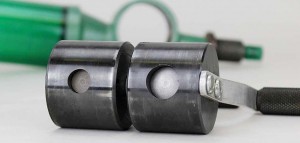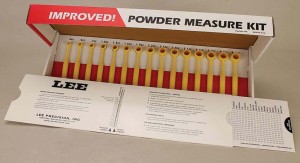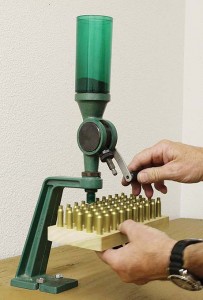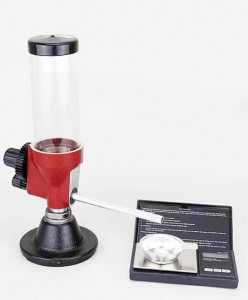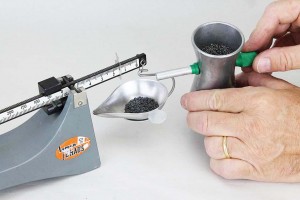by Art Merrill | Contributing Editor
 A friend once told me that, as a teen who didn’t know any better, his first foray into handloading was to simply dump pistol powder into .44 Special cases to where he estimated the bullet base would be upon seating.
A friend once told me that, as a teen who didn’t know any better, his first foray into handloading was to simply dump pistol powder into .44 Special cases to where he estimated the bullet base would be upon seating.
“I’m lucky to still have all my fingers,” he said. Though he suffered nothing more serious than excessive recoil and muzzle blast, failing to precisely measure or meter a powder charge can result in frustration, damaged firearms—or worse. He was, indeed, very lucky.
There are two basic methods for measuring a powder charge, by volume or by weight. Even if we load metered volumes of smokeless powder from a powder measure, we still must use a scale to arrive at that desired volume of powder because reloading manuals list powder charges by WEIGHT, not by VOLUME.
Scales
We weigh charges on powder scales, which may be either mechanical or electronic. The mechanical scale uses gravity and a balance beam; it is slower to use than an electronic scale, but gravity is free, whereas the latter need batteries or electricity and typically cost more than balance beam scales. With the balance beam scale you set the sliding weights to your desired weight of powder charge then add powder to the pan until gravity pulls the pan downward, the other end of the beam moves upward and the pointer on the end of the beam centers on the scale when the weight is correct.
With either type scale you need a powder trickler. The trickler has a small powder reservoir through which a rotating hollow tube passes. The inside of the tube is threaded like a screw. When rotated, a port in the hollow tube picks up the powder granules and the screw threads carry them down the tube to fall into the powder scale pan. You can literally add extruded powder to the pan by individual granules. The practice is to set your scale to the desired powder charge, use a dipper (kitchen measuring spoons work) or powder measure to throw about 95 percent of that charge, then top it off with the trickler. The method produces very precise loads.
Over the decades I must have loaded many tens of thousands of rounds for competition and hunting using this method, and sometimes I still do. But now that I live in the digital future I’ve adopted the convenience of the combination electronic scale/dispenser, a major time saver when volume reloading. The speed-up comes from the unit dispensing the correct charge at the push of a button while I seat bullets, essentially cutting charging-and-seating time by about two-thirds.
But it isn’t always necessary or desirable to weigh every charge; we can instead throw charges metered by volume from powder measures directly into cases.
Mechanical measures
Powder measures have an attached reservoir for the powder. They are basically all the same, differing only in the details as makers strive for the better mousetrap and to avoid patent infringements. What they share in common is that they measure or meter a volume of powder. Mechanical powder measures generally have a rotor with an adjustable cup that “throws” the powder charge when the handloader pulls a handle attached to the rotor below the reservoir. Some, like the RCBS, have two separate rotors, one for rifle powders and the other for pistol powders. The difference is that the rotor intended for rifle powders has a larger diameter cup to hold the larger volume (and larger granules) of rifle powders. Some makers have “micrometer” adjustments with repeatable settings so that you can record the setting in your load data and use it again later if you change the measure’s setting for other loads. These adjusters are also offered as accessory upgrades to your powder measure.
To find the proper volume of powder, the handloader must go through a trial-and-error process of weighing the powder charges as he makes adjustments to the powder measure’s rotor cup volume. Throw a charge and weigh it; if it isn’t correct, adjust the measure and throw and weigh another charge. Once you’ve got the charge weight you want and have locked the adjustment, you can now throw charges directly into the cases. It’s a good idea during loading to occasionally weigh a charge to ensure Murphy hasn’t gotten into the powder measure somehow.
Mechanical powder measures are typically not free-standing, though they usually include a way to clamp or screw them to your reloading bench. Most manufacturers offer powder measure stands as accessories for an additional price; these stands also must be clamped or bolted to your bench.
Going digital
Digital electronic measures may or may not include a programmable powder dispenser. The programmable dispenser is essentially a mini-computer you program to throw a specific weight of powder using its integral trickler. The scale “talks” to the dispenser and causes it to stop dispensing at the programmed weight. Electronic scales without dispensers are a fraction of the cost of those that have them, and are used in the same manner as balance beam scales: throw about 95 percent of your charge and trickle the remainder.
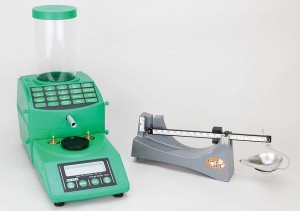
Integral electronic scale/dispensers are great for volume reloading, but balance beam scales have advantages, too.
Hornady has a pocket-size electronic scale for about $40, another for about $123, and full-on integral programmable dispenser and scale for about $320. The RCBS electronic scale runs just under $100, and for another $250 you can add the programmable dispenser. Lyman’s programmable dispensers start at $300. There are others, but this sampling gives you an idea of your cost. When buying, it behooves you to first investigate the repair warranty. When my programmable failed after two years it cost me a flat $60 for a factory repair. When my friend’s identical programmable failed a year later the flat rate repair cost had shot up to well over $200, approaching the cost of the unit.
In addition to speeding up reloading, another advantage to electronic scales is that they instantly determine the weights of unknowns, such as a bullet or powder charge pulled from a cartridge; balance beam scales require a ballpark guess and then a bit of fiddling with the sliding weights.
Dip it
The exception to weighing charges is the Lee Precision Improved Powder Measure Kit. With this inexpensive set of powder dippers, no weighing is necessary. Measured in cubic centimeters, each dipper holds a different volume. You simply reference the powder you’re using to the provided chart, and the chart tells you what dippers to use to achieve your desired weight of powder. This system avoids the expense of scales and measures, but it is not as precise as weighing charges and can be a bit slow for high-volume reloading. However, the dippers have nothing to get out of adjustment or to fail, either.
Regardless of what methods and specific tools you use, the most important thing is to be sure you charge every case with the correct amount of powder. You have a lot of options in getting there.
Squib loads
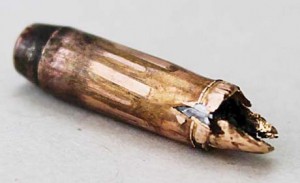 Inattention can lead to a failure to charge a case with powder before seating a bullet, creating a dangerous “squib load” situation where the force of the primer alone is enough to drive the bullet out of the case and partially down the bore. The photo here is of a .223 bullet from a squib load.
Inattention can lead to a failure to charge a case with powder before seating a bullet, creating a dangerous “squib load” situation where the force of the primer alone is enough to drive the bullet out of the case and partially down the bore. The photo here is of a .223 bullet from a squib load.
An acquaintance recently brought his AR-15 into the shop with the bullet lodged in the bore; the bullet nose, to the right in the photo, is damaged from being driven forcefully out of the bore with a steel cleaning rod and hammer, but you can see the scorch from the primer’s ignition and rifling marks on the bullet shank. He said he didn’t notice the lack of a full-on “bang” from the squib load while rapid firing; luckily the bullet lodged so that the next cartridge could not fully chamber, stopping the bolt carrier from going into battery and preventing firing the next round.
If the bullet had traveled a fraction of an inch further, allowing the next round to chamber and fire, he would have likely suffered a “kaboom” and possibly serious injury. Always visually check every case for a powder charge before seating bullets.

